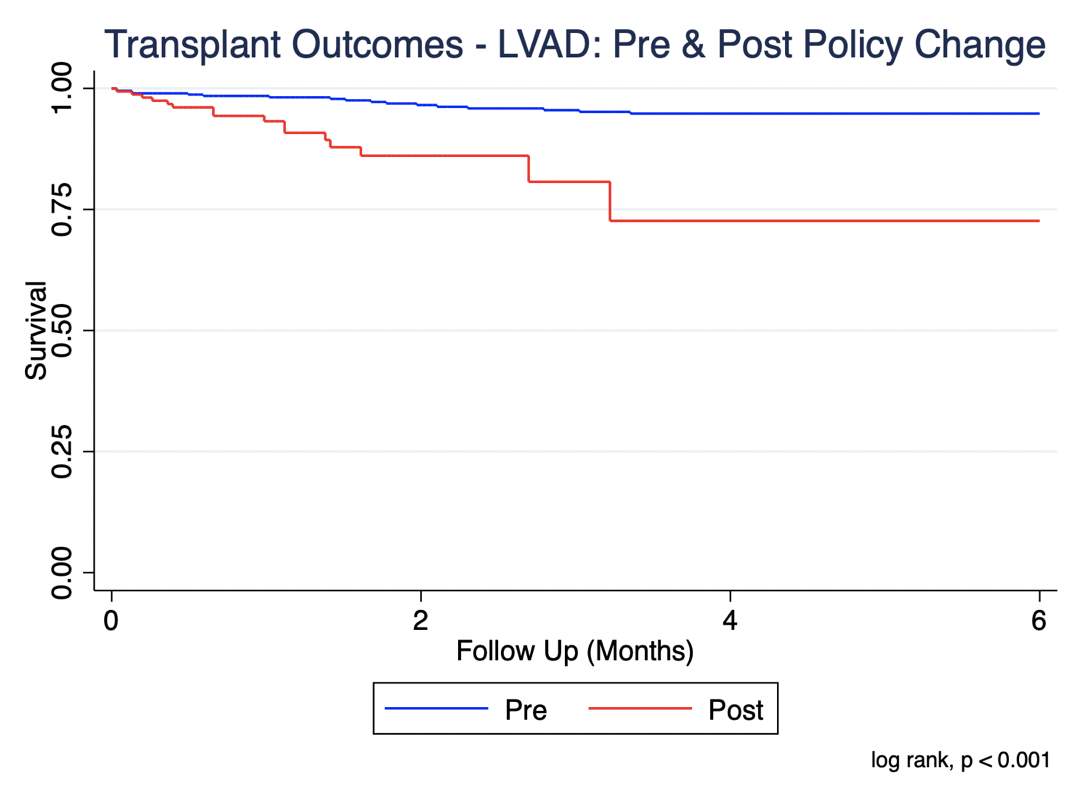Heart Transplant Outcomes for Patients with Left Ventricular Assist Devices (LVAD) Before and after the 2018 Revision of the United Network for Organ Sharing (UNOS) Adult Heart Allocation System
1Cardiology, LAC-USC, Los Angeles, CA, 2University of Arizona Sarver Heart Center, Tuscon, AZ, 3UCLA Medical Center, Los Angeles, CA, 4Harbor-UCLA Medical Center, Los Angeles, CA, 5Newark Beth-Israel Medical Center, Newark, NJ, 6The Queen's Medical Center, Honolulu, HI
Meeting: 2020 American Transplant Congress
Abstract number: C-287
Keywords: Allocation, Heart/lung transplantation, Survival
Session Information
Session Name: Poster Session C: Heart and VADs: All Topics
Session Type: Poster Session
Date: Saturday, May 30, 2020
Session Time: 3:15pm-4:00pm
 Presentation Time: 3:30pm-4:00pm
Presentation Time: 3:30pm-4:00pm
Location: Virtual
*Purpose: In October of 2018 UNOS chaged their adult heart allocation criteria to address disparity in waiting list survival. The implications of this policy change on patients with left ventricular assist devices is unknown.
*Methods: 577 LVAD patients were identified from the UNOS registry and grouped based on initial listing 6 months prior to (n= 408) and 6 months post (n=169) the policy change. Patient characteristics and transplant survival were assessed, and a cox multivariate proportional hazards regression analysis was preformed (adjusting for age, sex, diabetes, ethnicity, ischemic time, days waiting).
*Results: During the study period, 408 and 169 heart transplants occurred before and after UNOS policy change. Between groups there was no difference in age, gender, ethnicity, smoking, diabetes, creatinine, hemodynamics, IABP or ventilator support. Post policy change, LVAD patients had shorter waiting times with median 18 (IQR 8-52) vs 65 days (IQR 24.5-125) (p<0.001). There was significantly lower post-transplant survival in LVAD patients post policy change [HR 5.63 (2.2-14.5), p= < 0.001].
*Conclusions: Post UNOS policy change LVAD patients had lower overall post-transplant survival with the majority of these patients transplanted at statuses 1-3, despite shorter waiting time and similar baseline characteristics. Further study is warranted to understand the longterm implications of this policy change in this patient population.
To cite this abstract in AMA style:
Pizula J, Yang K, Li J, Shah S, Liu G, Lee A, Banankhah P, Nattiv J, Miklin D, Genyk P, Kingsford P, Pandya K, Joeseph R, Fong M, Luanda G, Kiankhooy A, Hashmi S, Nuno S, Wolfson A, Salimbangon A, Chand R, Vucicevic D, Corey L, Depasquale E, Vaidya A. Heart Transplant Outcomes for Patients with Left Ventricular Assist Devices (LVAD) Before and after the 2018 Revision of the United Network for Organ Sharing (UNOS) Adult Heart Allocation System [abstract]. Am J Transplant. 2020; 20 (suppl 3). https://atcmeetingabstracts.com/abstract/heart-transplant-outcomes-for-patients-with-left-ventricular-assist-devices-lvad-before-and-after-the-2018-revision-of-the-united-network-for-organ-sharing-unos-adult-heart-allocation-system/. Accessed December 18, 2025.« Back to 2020 American Transplant Congress

